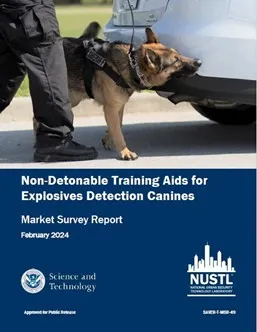FOR IMMEDIATE RELEASE
S&T Public Affairs, 202-286-9047
WASHINGTON - The Department of Homeland Security (DHS) Science and Technology Directorate (S&T) has released a new market survey report to help emergency responders identify non-detonable training aids for explosive detection canines. Non-detonable training aids emulate the scent of explosives, allowing canines to learn the specific odor of different types of explosives while eliminating the inherent risks of using traditional, live explosives. They are carefully designed and maintained to create a controlled and safe environment for training, with a focus on safety, effectiveness, and consistency in preparing canines for their crucial roles in security and public safety.

S&T’s National Urban Security Laboratory (NUSTL)—in conjunction with Johns Hopkins Applied Physics Laboratory—administered the Non-Detonable Trainings Aids for Explosive Detection Canines Market Survey Report, which provides information on 12 non-detonable training aid products ranging in price from $15 to $550. This report is based on information gathered from manufacturer and vendor materials, open-source research, industry publications, and a government-issued request for information. The report is part of NUSTL’s System Assessment and Validation for Emergency Responders (SAVER) program, which assists emergency responders in making procurement decisions.
“The Detection Canine Program at S&T plays a critical role in advancing the safety and effectiveness of explosive detection canines in the field,” said Guy Hartsough, S&T Detection Canine Program, program manager. “NUSTL’s comprehensive report provides valuable resources in an ever-evolving landscape of threats, underscoring our dedication to enhancing the capabilities of our nation's security responders.”
“Explosive detection canines are critical to protecting the public as well as the first responders they assist. Rigorous training is required to prepare these dogs for the field” said NUSTL Director Alice Hong. “NUSTL’s latest market survey report equips explosive detection canine handlers with crucial insights into non-detonable training aids.”
Visit the SAVER website for market research and comparative assessments of commercially available products. Results are published to assist responders in making informed technology deployment and purchasing decisions for their agency’s specific needs. SAVER documents with limited distribution are available to members of the SAVER Community by contacting NUSTL@hq.dhs.gov.
For more information about NUSTL and its mission as the only national laboratory dedicated to serving the nation’s first responders, visit www.dhs.gov/science-and-technology/national-urban-security-technology-laboratory
###
